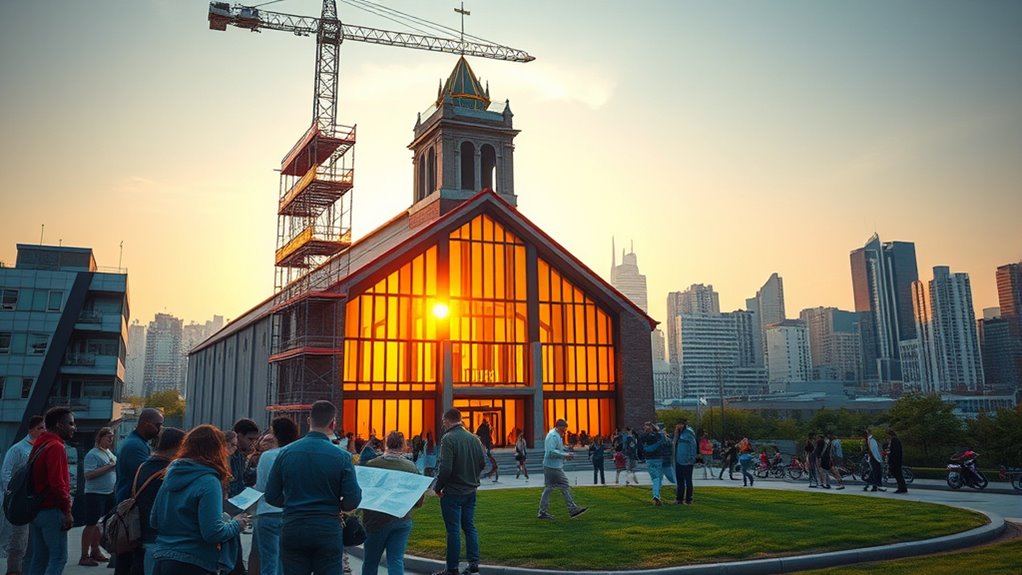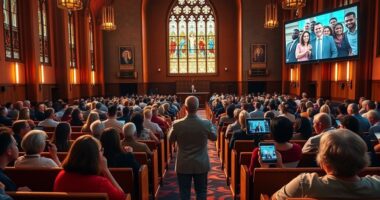In 2025, new churches are essential to connect with rapidly changing communities and meet diverse spiritual needs. They create welcoming spaces for different demographics, foster genuine relationships, and better adapt outreach strategies like social media and innovative formats. These churches help make faith accessible and relevant, especially to marginalized groups. If you want to discover how these strategies can transform communities and strengthen your own faith journey, keep exploring what’s ahead.
Key Takeaways
- Rapid community changes require new churches to address evolving spiritual and social needs effectively.
- Innovative formats and digital outreach expand accessibility, attracting diverse populations and fostering inclusivity.
- New churches serve as vital hubs for community engagement and outreach, strengthening local connections.
- Tailoring church models to cultural and demographic factors ensures relevance and sustainable growth.
- Addressing societal diversity and inclusivity needs makes new churches essential for meaningful community impact.

Are you wondering how church planting will evolve in 2025? As communities continue to change rapidly, you’ll find that starting new churches remains essential for fostering meaningful connections and addressing diverse spiritual needs. In fact, church growth hinges not only on attracting new members but also on creating spaces where people feel genuinely welcomed and supported. New churches serve as fresh hubs for community outreach, reaching those who might feel disconnected from traditional congregations or hesitant to join established churches. By planting new churches, you can tailor your approach to fit the unique cultural, social, and demographic makeup of your area. This personalized outreach boosts church growth because it demonstrates a commitment to meeting people where they are, rather than expecting them to come to a pre-existing structure.
Starting new churches fosters genuine community connections and adapts to local cultural and social needs.
In 2025, the need for new churches becomes even more apparent as society becomes increasingly diverse and digitally connected. Many individuals seek authentic community, and new church plants are often better positioned to foster that intimacy. They can prioritize innovative outreach strategies, such as leveraging social media, hosting community events, or partnering with local organizations. These efforts amplify your community outreach, making your church a crucial part of local life. As a result, you’ll notice growth not just numerically but also in the depth of relationships formed within your congregation. People are craving genuine connections, and new churches can meet this demand more effectively by customizing their approach based on local needs.
Furthermore, church planting in 2025 will likely involve a strategic focus on reaching underrepresented or marginalized groups. Established churches may struggle to adapt quickly, but new churches can be designed from the ground up with inclusivity in mind. This proactive stance enhances community outreach and accelerates church growth by creating spaces where diverse populations feel seen and valued. You’ll also find that new church plants often adopt innovative formats—such as house churches, online ministries, or multi-site models—that appeal to different lifestyles and schedules. These approaches help you reach more people, especially those who might not attend traditional Sunday services.
Additionally, understanding the importance of caregiver support can help new churches develop programs that meet the needs of families and individuals facing ongoing challenges, further strengthening community bonds.
Ultimately, planting new churches in 2025 isn’t just about increasing numbers; it’s about actively engaging with your community, fostering authentic relationships, and creating sustainable growth. By focusing on community outreach and understanding the evolving needs of your area, you can build a church that genuinely transforms lives and becomes a cornerstone of its community. This proactive and adaptive approach ensures that your church remains relevant, impactful, and vibrant in the years to come.
Frequently Asked Questions
How Will Technology Influence Church Planting Strategies in 2025?
Technology will profoundly shape your church planting strategies in 2025 by enabling virtual worship and digital evangelism. You can reach wider audiences through live-streamed services and engaging online content, making it easier to connect with people who might not attend physically. By leveraging these tools, you’ll foster community, share the gospel effectively, and plant new churches that meet people where they are, both online and offline.
What Role Will Social Issues Play in New Church Development?
You see, social issues are the backbone of new church development. You’ll find that engaging with social justice causes and community outreach helps build relevance and trust. By addressing these pressing concerns, you’re not just planting a church; you’re creating a essential hub for change. Your efforts will foster stronger connections, showing that faith and action go hand in hand, truly making a difference where it’s needed most.
How Can Churches Effectively Reach Non-Traditional Communities?
You can effectively reach non-traditional communities by practicing cultural sensitivity and actively engaging with locals. Listen to their stories, understand their needs, and tailor your outreach accordingly. Attend community events, partner with local organizations, and create inclusive spaces that reflect their diversity. By showing genuine interest and respect, you’ll build trust and foster meaningful connections, making your church a welcoming hub for those outside traditional settings.
What Funding Models Are Most Sustainable for New Churches?
You’ll find that sustainable funding models often hinge on donor partnerships and grant opportunities. By building strong relationships with donors, you create consistent support, while grants can provide vital startup funds. It’s no coincidence that churches combining these approaches often thrive long-term, diversifying income sources and reducing reliance on a single stream. Emphasizing stewardship and transparency also encourages ongoing support, ensuring your church’s growth and stability in the future.
How Will Demographic Shifts Impact Church Planting Priorities?
Demographic shifts will make you prioritize churches that embrace demographic diversity and foster community engagement. As populations become more diverse, you’ll need to plant churches that reflect and serve different backgrounds, cultures, and ages. Focusing on community engagement helps you build trust and meet specific local needs. By adapting your approach to these demographic changes, you make certain your church stays relevant, welcoming, and impactful in an evolving societal landscape.
Conclusion
You might think there’s no need for new churches now, but remember, new churches reach different communities and meet evolving spiritual needs. They offer fresh perspectives and opportunities for connection that existing churches may lack. If you believe your current church is enough, consider how planting new churches can complement and strengthen your faith journey. Together, we can create a vibrant, inclusive spiritual landscape that truly serves everyone in 2025 and beyond.










